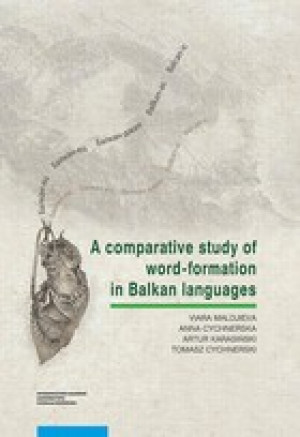
A comparative study of word-formation in Balkan languages
Producent: Uniwersytet Ekonomiczny w Katowicach
A comparative study of word-formation in Balkan languages PRACA ZBIOROWA Introduction
9
A. General issues (Viara Maldjieva)
Chapter I
A model for a comparative study of word-formation in Balkan languages
13
1. A comparative study of word-formation
13
2. The basic concepts of the description
15
3. Basic assumptions of the model of a comparative description of word-formation
20
3.1. General assumptions
20
3.2. Specific assumptions
22
Chapter II
Semantic properties of derivatives in Balkan languages
27
1. Semantic derivation
27
2. Semantic structure of derivatives. Derivational meaning
33
2.1. Lexical meaning and derivational meaning of a derived lexeme
33
2.2. Components of the semantic structure of a derivative
35
2.3. Derivational paraphrase
42
3. Types of meaning relations between the concepts in the semantic structure of derived words. Derivational categories
44
3.0. Derivational category
44
3.1. Argument categories
46
3.2. Argument categories in structures with an unexpressed predicate
52
3.3. Predicative categories
59
3.4. Summary
76
Chapter III
Formal and functional properties of derivatives in Balkan languages
79
1. Formal properties of derivatives
79
1.1. Synchronic derivational division
79
1.2. Types of base
83
1.3. Types of formant
86
1.4. Variation of bases and formants
92
1.5. Distribution of formants
96
1.6. The formal structure of derivatives
97
2. Functional properties of formants
104
2.1. Functions of formants in the structure of derivatives
104
2.2. Formants with semantic function - exponents of derivational categories
105
2.3. Homonymy and polyfunctionality of formants
105
B. The detailed analysis (Viara Maldjieva, Anna Cychnerska, Artur Karasiński, Tomasz Cychnerski)
Chapter I
Argument categories
117
1. Bulgarian (V. Maldjieva)
118
2. Macedonian (A. Cychnerska)
149
3. Serbian (A. Cychnerska)
177
4. Albanian (A. Karasiński)
208
5. Romanian (T. Cychnerski)
227
6. Summary (V. Maldjieva)
245
Chapter II
Structures with an unexpressed predicate
249
1. Bulgarian (V. Maldjieva)
250
2. Macedonian (A. Cychnerska)
252
3. Serbian (A. Cychnerska)
255
4. Albanian (A. Karasiński)
258
5. Romanian (T. Cychnerski)
261
6. Summary (V. Maldjieva)
263
Chapter III
Predicative categories
265
1. Bulgarian (V. Maldjieva)
265
2. Macedonian (A. Cychnerska)
319
3. Serbian (A. Cychnerska)
371
4. Albanian (A. Karasiński)
432
5. Romanian (T. Cychnerski)
453
6. Summary (V. Maldjieva)
480
Chapter IV
Variation of formants
483
1. Bulgarian (V. Maldjieva)
484
2. Macedonian (A. Cychnerska)
488
3. Serbian (A. Cychnerska)
494
4. Albanian (A. Karasiński)
500
5. Romanian (T. Cychnerski)
503
6. Summary (V. Maldjieva)
506
Chapter V
The distribution, homonymy, and polyfunctionality of formants
507
1. Bulgarian (V. Maldjieva)
508
2. Macedonian (A. Cychnerska)
526
3. Serbian (A. Cychnerska)
542
4. Albanian (A. Karasiński)
560
5. Romanian (T. Cychnerski)
567
6. Summary (V. Maldjieva)
575
Chapter VI
Formal structures of single-stem derivatives
579
1. Bulgarian (V. Maldjieva)
580
2. Macedonian (A. Cychnerska)
581
3. Serbian (A. Cychnerska)
583
4. Albanian (A. Karasiński)
585
5. Romanian (T. Cychnerski)
587
6. Summary (V. Maldjieva)
589
Conclusion
591
References
593
Sklep: gandalf.com.pl
Cena:
47.66
40.04
Przejdź do sklepu